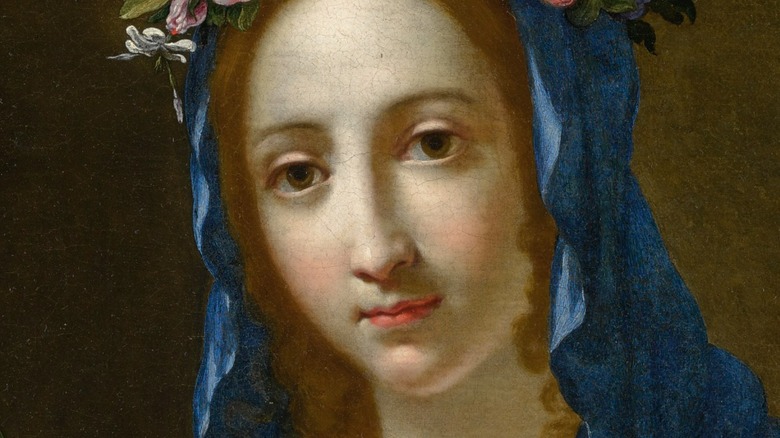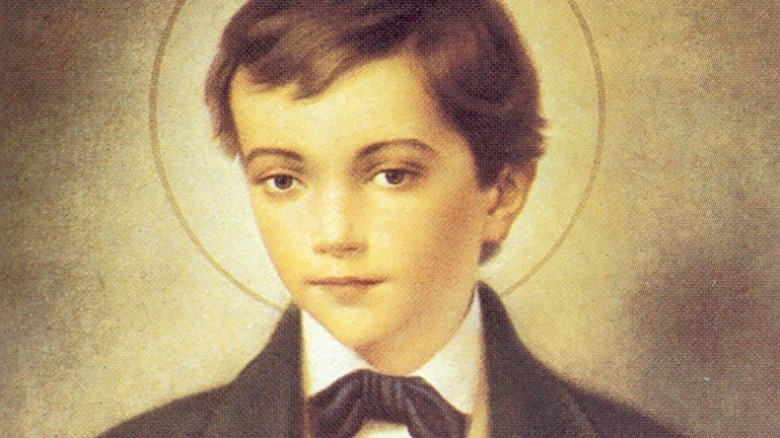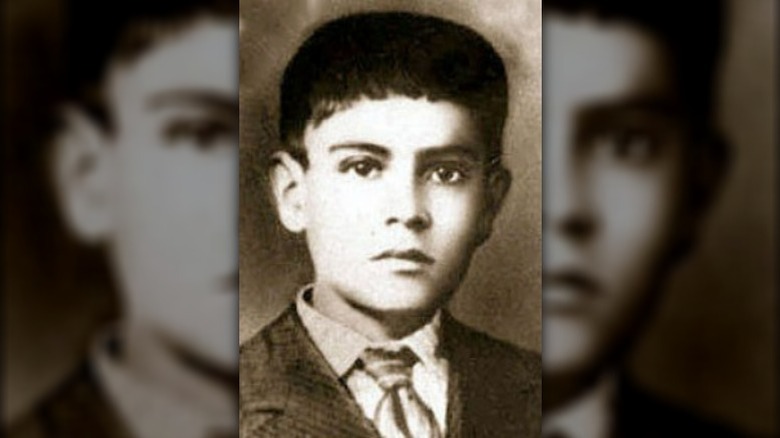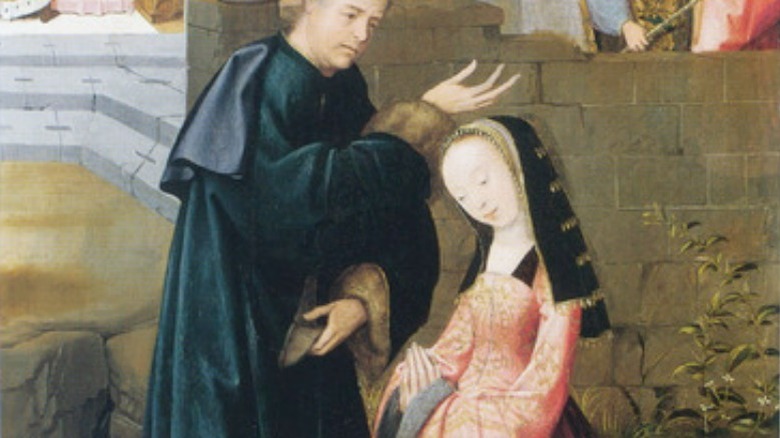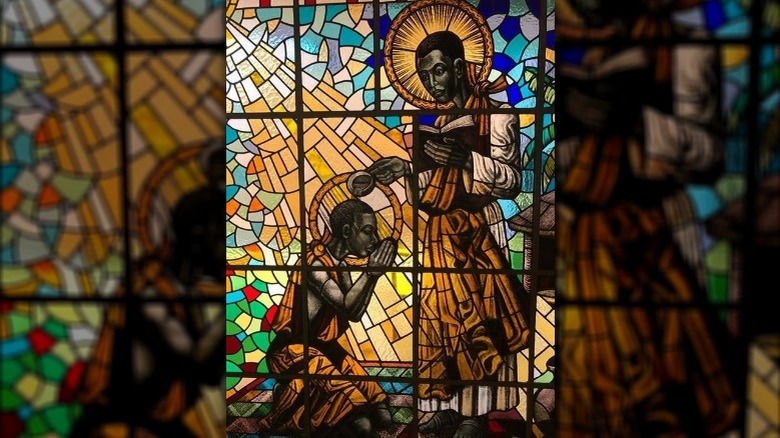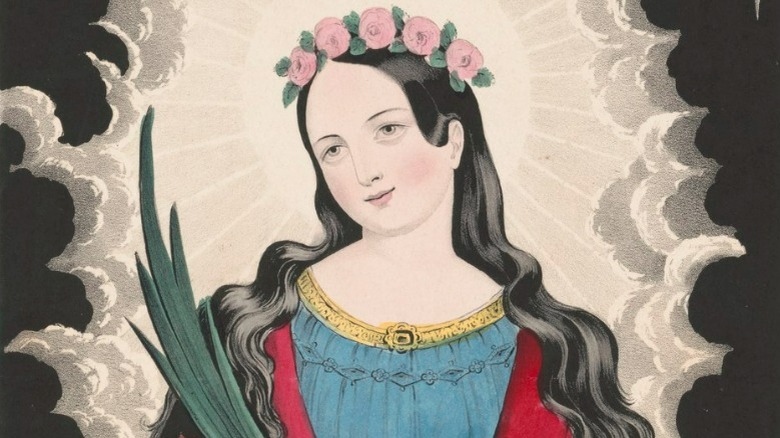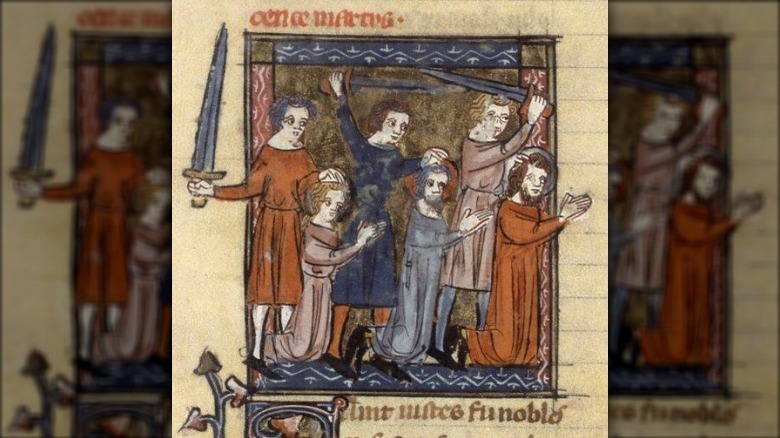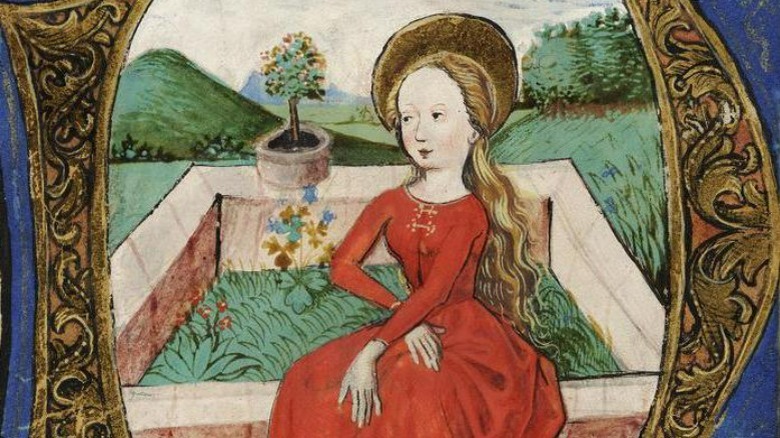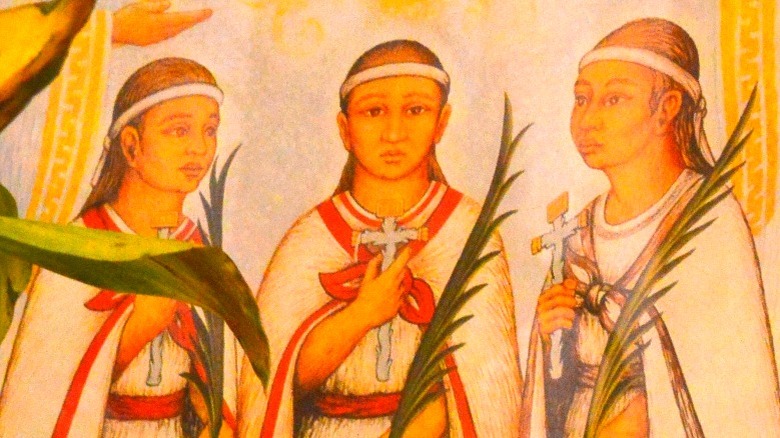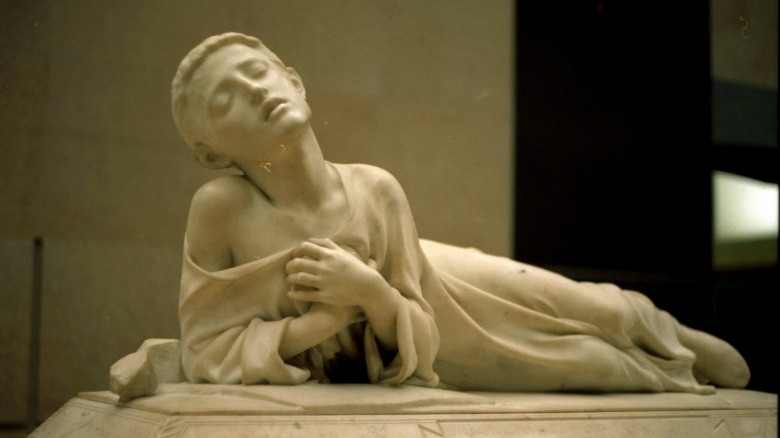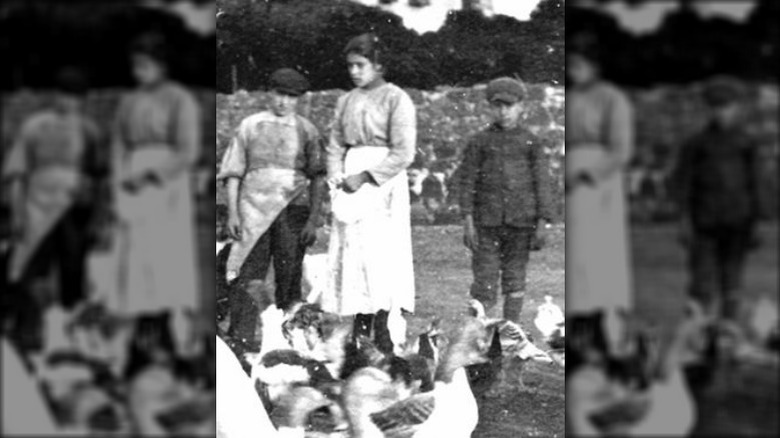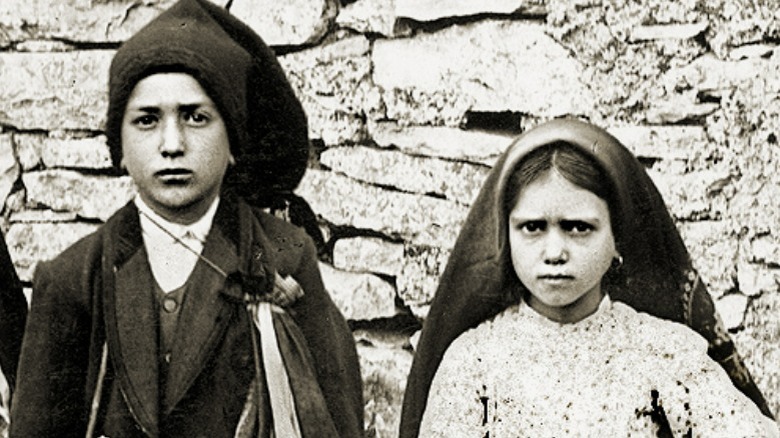The Youngest Saints In The Catholic Church
It seems like living a life worthy of sainthood would take a lot of work. After all, there are plenty of good people in the world, so to be considered holy enough to reach the level of a literal saint would surely take decades of dedication (as well as being Catholic, obviously). There are hundreds of saints who lived long lives full of good deeds and good works, and their stories are certainly impressive. But the fact that a child barely in their teens — or even younger — could pack in enough in that time to be considered on the same level is pretty astonishing.
Some of the youngest saints recognized by the Catholic Church circumvented the difficulty of getting all that holiness into a few short years by not actually existing. While they are recognized as legendary, these children are still considered saints and therefore count. But plenty of other young people who would go on to be canonized by the Catholic Church undoubtedly existed: There are even photographs of several of them.
While there are some locally venerated saints not recognized by the Vatican who died young, as well as children who are well on their way in the process of becoming official saints but just haven't made it there as of 2023, these are the youngest saints who have gotten that full pope approval.
St. Dominic Savio
Dominic Savio was born in Turin, Italy on April 2, 1842. There, he came under the tutelage of John Bosco at a young age. According to "Don Bosco: A Sketch of His Life and Miracles," the older man devoted his life to helping local children in need and giving them practical and religious tools for life. Dominic would become his most famous pupil, known not just for his extreme piety and willingness to suffer in service to the Catholic Church, but also for his mystic prophecies. The latter was taken so seriously that Dominic even influenced a major decision of the pope's when he was only 8, per "The Encyclopedia of Saints."
John Bosco wrote Dominic's biography, in which he explained the boy seemed to be aware he would die young, although on his deathbed, after a slow, lingering illness, doctors thought he would recover. While some sources record that Dominic was 15 when he died, he was actually a few weeks shy of that birthday, dying at 14 years, 11 months, and 8 days old.
Originally, the idea of making such a young child who didn't die a martyr into a saint was controversial. John Bosco was canonized in 1934, but it would be 20 more years before Dominic was. Pope Pius X defended the decision, saying, "A teenager such as Dominic, who bravely struggled to preserve undefiled his baptismal innocence to the very last, is indeed a saint" (via "Saint Companions for Each Day").
St. Jose Sanchez del Rio
Jose Sanchez del Rio was born in Mexico on March 28, 1913. When he was only 13 years old, widespread violence that would become known as the Cristero Rebellion broke out in the country. Religious Catholics felt the federal government was infringing on the rights of the Church, and Jose asked his mother if he could join the fighting despite his young age, according to the Vatican. After a battle in 1928, Jose was captured and tortured. He knew his death was inevitable.
Jose's murder was witnessed by multiple people, including his friend and future cardinal Marcial Maciel. Maciel recorded the event in his autobiography (via Catholic News Agency), writing that their captors "cut the bottom of [Jose's] feet and obliged him to walk around the town toward the cemetery. He cried and moaned with pain, but he did not give in. At times they stopped him and said, 'if you shout 'Death to Christ the King' we will spare your life.' Jose Luis finally died shouting 'Long live Christ the King' while his assassins fired upon him." (Full disclosure: Decades later, Cardinal Maciel was accused of being, as The Guardian put it, "perhaps the Roman Catholic Church's most notorious pedophile.")
Jose was 14 years, 10 months, and 14 days old when he was martyred. In 2008, his intercession was credited for the seemingly miraculous recovery of a brain-damaged infant, per Catholic News Agency. As a result, Jose Sanchez del Rio was canonized in 2016.
St. Dymphna
The evidence for many Catholic saints existing, let alone the details in stories told about them, is often almost nonexistent. The 1909 version of "The Catholic Encyclopedia" (via New Advent) admits that St. Dymphna's "narrative is without any historical foundation." However, belief in and veneration of these legendary individuals can still have important consequences.
St. Dymphna's tale begins in Ireland in the seventh century, according to "Saints Preserved: An Encyclopedia of Relics," which also notes that the first written account of her life wouldn't exist for another 600 years. The story goes that after her mother died, her father refused to marry anyone less beautiful than she had been ... which resulted in him selecting his daughter, a recently converted Christian, as his new bride. Instead of agreeing to the incestuous marriage, Dymphna fled to Europe, eventually settling in what is now Geel, Belgium. When her furious father tracked her down, he cut off her head himself, per "Saints: Faith Without Borders." If she did exist, her birth and death dates are not known, although tradition has it that she was 14 or 15 years old when she died.
The sight of this filicide allegedly shocked numerous mentally unwell witnesses so much that their sanity was restored. Because of this, St. Dymphna became the patron saint of mental illness and Geel transformed into a revolutionary mental health treatment destination, where patients were allowed to exist in the world rather than being locked up as they recovered.
St. Kizito
St. Kizito was born in Uganda around 1872. He came under the protection of a powerful adopted father and got a prestigious position as a page boy in the court of Mwanga II, the Kabaka of Buganda. However, according to "African Holocaust: The Story of the Uganda Martyrs," the ruler made sexual advances to the boy and was rejected. Kizito was a follower of "the French religion," or Catholicism, and had seen other Ugandan Christians be executed and tortured for their beliefs. Perhaps knowing what rebuffing the kabaka would cost him, Kitzito was quickly baptized late at night.
The next day, he and other Catholics were separated from the non-Christians of the court and sentenced to death, per the Munyonyo Martyrs' Shrine official site. One witness said Kizito seemed completely unbothered, looking "as happy as if he were at play with his friends." The condemned were put in slave yolks and forced to walk almost 30 miles before being burned to death on June 3, 1886. Sources give varying ages for Kizito when he died, ranging from 13 to 16, although tradition seems to hold he was about 14.
The youngest of the group known as the Ugandan Martyrs, Kizito was canonized along with the rest of the group in 1964. He also became the patron saint of the children of Uganda. More recently, the late archbishop of Kampala, Cyprian Kizito Lwanga, founded the Association of the Bannakizito to help children grow in the Catholic faith.
St. Philomena
St. Philomena is another one of those saints about whom very little is known. In fact, according to "St. Philomena: The Wonder-Worker," there's some confusion about if Philomena is even still a saint at all. The short answer is yes. However, she was one of many saints who were given less prominent standing in the church during the Second Vatican Council (a.k.a. Vatican II) in 1961.
Philomena is acknowledged to be one of some of the more questionable "discoveries" of Catholic martyrs. According to "The Catholic Encyclopedia" (via New Advent), her body was uncovered in the catacombs of Rome in 1802. The people who did the finding had set out to discover some martyrs, so it's really no surprise they did. Under a stone with the name Philomena was the body of a girl buried with an ampulla. A popular belief at the time was that any bodies found buried with a vial filled with a reddish substance were martyrs, their fluids conveniently preserved as relics for future grave diggers. (This was eventually proved to be untrue, and testing showed it was not even blood in the vials.) Nevertheless, Philomena was declared a Catholic martyr.
Everything else about St. Philomena is completely made up, as even The Catholic Encyclopedia admits. As the 1854 work "The Life of St. Philomena" puts it, the saint gave revelations about her life to various people. These stories put her at about 13 and a half when she died.
St. Vitus
St. Vitus first appeared in the "Martyrologium Hieronymianum," an early medieval list of saints and which days of the year they should be celebrated, according to "Saints in Art." However, there is no evidence for the existence of Vitus. The events of his life, as described by legend, are pretty extraordinary, however.
While still a young boy, Vitus started performing miracles. Rather than being impressed with his son's supernatural abilities, Vitus' father tried to get him to give up his Christian beliefs and become pagan, even resorting to torture. So the boy fled to Rome, per "Butler's Saint for the Day," where he kept performing miracles, including curing the epilepsy of the son of the Roman emperor. Once again, this man was not amazed at Vitus' amazing powers. Instead, he threw him in prison and executed him in 303, as the legend goes, when Vitus was about 12 or 13 years old.
Because of his alleged healing abilities, St. Vitus not only became the patron saint of epilepsy but even got a medical condition named after him: St. Vitus' Dance. An article in the CDC's journal Emerging Infectious Disease explains that during the Middle Ages, any condition that caused involuntary movements and twitching would get this label. In the 1600s, epidemiologist Thomas Sydenham observed, "The patient cannot keep [his hand or leg] a moment in its place ... Do what he may, it will be jerked elsewhere convulsively." Modern doctors understand these symptoms are connected to rheumatic fever.
St. Agnes of Rome
A recurring theme among female saints of the Catholic church is that they would rather die than marry. This has been true since the earliest years of the religion, but, as the 1907 version of "The Catholic Encyclopedia" (via New Advent) put it: "Of all the virgin martyrs of Rome none was held in such high honor by the primitive church, since the fourth century, as St. Agnes."
While there is little proof of Agnes' life, there are several near-contemporary records of her death, so there might be a bit more evidence for her existence than for some early saints. However, the details usually included in her story are almost certainly all legendary. According to Catholic News Agency, Agnes was from a rich and important family, which meant powerful men in Rome wanted to marry her. She refused all of them, with the implication that she would stay single because of her belief in Christianity. That was a problem, however, since this was during one of the many periods of persecution of the religion in ancient Rome (although sources disagree on which one).
When the emperor found out, he gave her the choice of marriage or death. Agnes chose death. Some versions of her story say she was forced to work in a brothel before being killed, but the man who attempted to have sex with her was struck blind. Legend has it, Agnes was about 12 or 13 years old when she was martyred.
The Child Martyrs of Tlaxcala
Collectively, Saints Cristóbal, Antonio, and Juan of present-day Mexico are known as "The Child Martyrs of Tlaxcala." All estimated to be about 12 or 13 when they were killed, the three boys were canonized on the same day in 2017 and the trio was recognized as the first Catholic martyrs in the Americas. However, their deaths occurred in two different years.
The dozen missionaries who sailed for the New World with Hernán Cortés started converting Aztecs and other native peoples as soon as they landed in 1524. One of their early and passionate converts, Cristóbal, was, according to Aleteia, the son of an important local chief. While he was originally only sent to the missionaries for schooling and not for religious education, Cristóbal became so fanatical about the Catholic faith that he would even smash up alters and offerings to Aztec gods in his father's own house. Furious, his father beat his son before throwing him into the fire. Cristóbal died in 1527, and "A Troubled Marriage: Indigenous Elites of the Colonial Americas" records that this murder had major repercussions throughout the region when it came to relations between the Spanish and Aztecs.
Two years later, Antonio and Juan, also upper-class boys (although some sources record Juan was Antonio's servant) who had attended the same school as Cristóbal, became missionaries for their new faith. Once they, too, began destroying idols of local gods, they were killed in 1529.
St. Tarcisius
St. Tarcisius lived in Rome during the third century and, despite his young age, was already working his way up the church hierarchy as an acolyte and was acquainted with the pope. His Holiness even gave the boy an important job: bringing the bread needed for Communion to Christians being held in Roman prisons that were scheduled to be executed. The assumption was that there was no way a priest could smuggle in contraband and even an older man would be suspicious. But a 12-year-old boy could get away with it.
Sadly, Tarcisius never made it to the prison. On his way there, a group of men accosted him and demanded to know what he was carrying. Rather than give them the bread which had been blessed by the pope, Tarcisius let them beat him to death. When the men searched his corpse, the bread had miraculously disappeared.
However, other than the discovery of a grave in the Roman catacombs bearing the same name, all this information originally comes from a poem written by Pope St. Damasus I about a century after the event would have occurred. Still, the 1912 version of "The Catholic Encyclopedia" (via New Advent) insists, "This tradition so positively asserted by Damasus is undoubtedly historical." In other words, since the pope really seems to mean what he wrote in the poem, it must be true. Something to consider if you still have your middle school journals lying around that future historians might take seriously.
St. Maria Goretti
As "St. Maria Goretti: In Garments All Red" points out, there are many thematic parallels between the deaths of Marie and St. Agnes, whose story was discussed in a previous slide. However, unlike the many virgin martyrs from the early centuries of the Christian church, there is no question of Maria's existence or her gruesome death.
Maria Goretti was born in Italy in 1890 to a poor family. Before she was even 12 years old, she was repeatedly sexually harassed by a 29-year-old local man named Alessandro Serenelli. Finally, one day in 1902, he forced himself on her, and when she fought back, he stabbed her 14 times. She took two days to die, and allegedly forgave Serenelli on her deathbed. She was 11 years, 8 months, and 21 days old.
According to his obituary in The New York Times, Serenelli got 30 years in prison, where he claimed to have a vision of his victim forgiving him, which made him turn his life around. Maria was made a saint in 1950, based partially on the evidence of his vision, and Serenelli, out of prison and living in a monastery by that point, attended the canonization ceremony at the Vatican. At the time, Maria Goretti was the Catholic Church's youngest named saint ever.
If you or anyone you know has been a victim of sexual assault, help is available. Visit the Rape, Abuse & Incest National Network website or contact RAINN's National Helpline at 1-800-656-HOPE (4673).
St. Francisco Marto and St. Jacinta Marto
The two youngest saints recognized by the Catholic Church as of 2023 were brother and sister, whose fame and eventual sainthood stem from the same event. One of the most famous Catholic miracles of the modern era is the appearance of the Virgin Mary to a huge crowd of people in Fátima, Portugal on October 13, 1917. The reason the crowd was there at all, however, was because of the visions of three young children, which they had been receiving for years.
Francisco and Jacinta Marto would regularly go into the local hills with their cousin Lucía Santos to watch her family's sheep. Soon, they claimed they started being visited by an angel and, eventually, the Virgin Mary herself. When news of the visions spread locally, some people mocked the trio, but others believed, leading to the mass vision in 1917.
Two of the three children would not be around long enough to see how famous their miracle became. Both Francisco and Jacinta were victims of the 1918 flu pandemic. Francisco died of it on April 14, 1919, aged 10 years, 9 months, and 25 days. The effects of the disease on Jacinta were not as quick. She lingered, undergoing hospitalization and surgery before finally dying on February 20, 1920, aged 9 years, 11 months, and 10 days. Their cousin Lucía would live to be 97. Francisco and Jacinta Marto were canonized in 2017.
